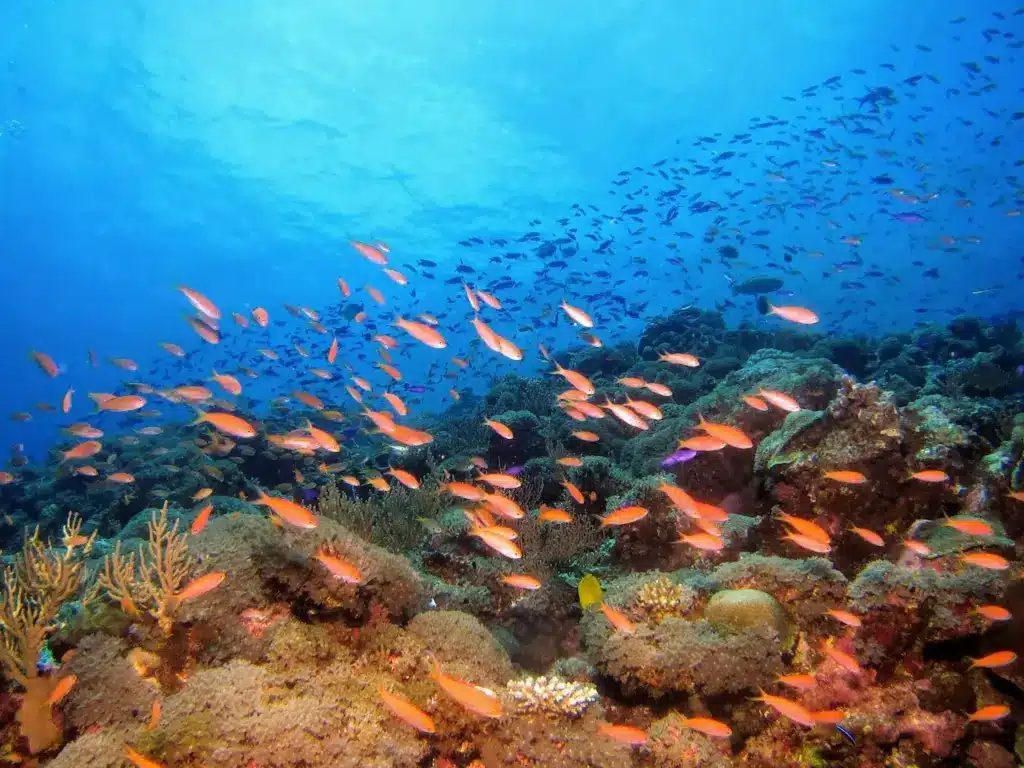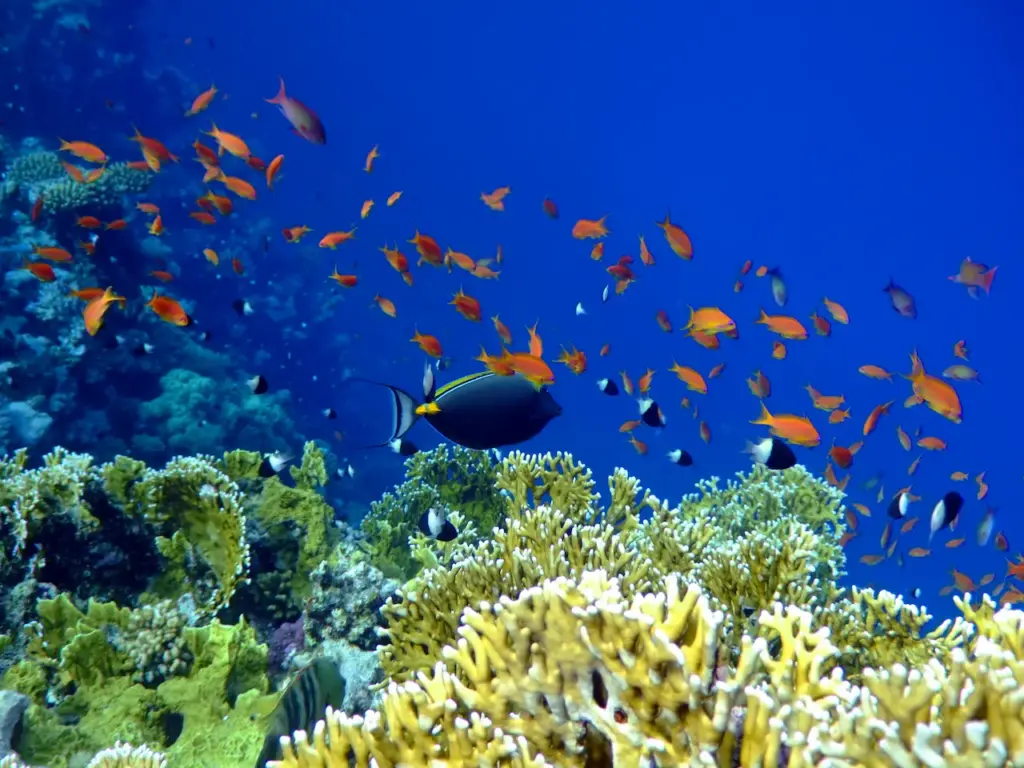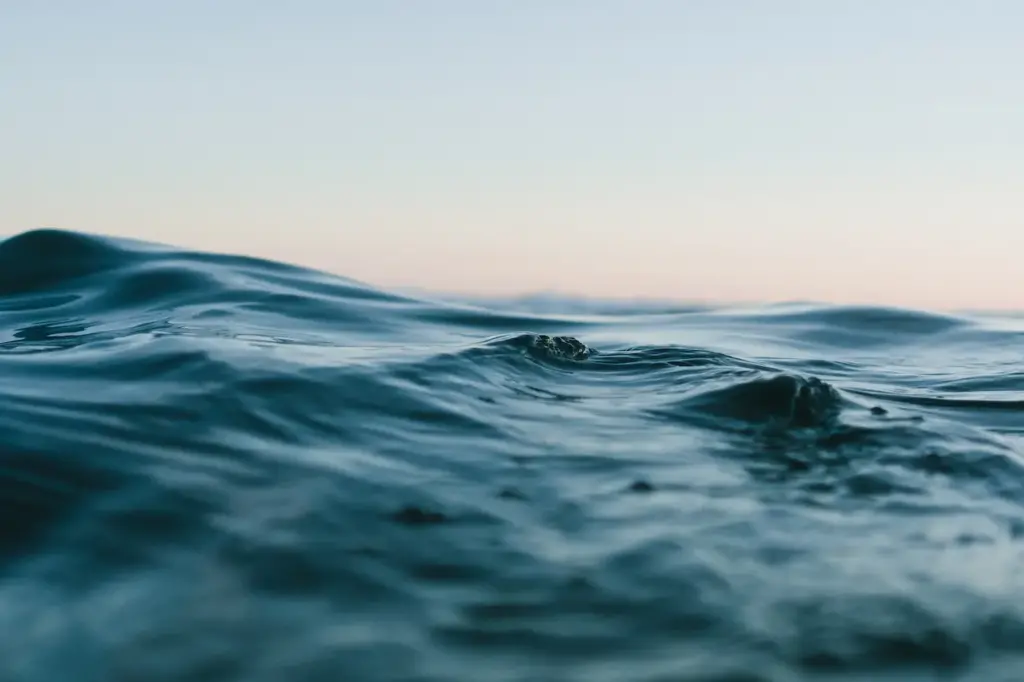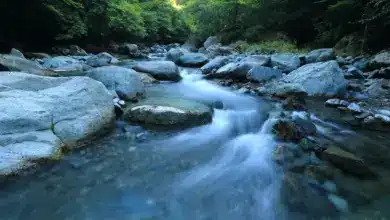Saltwater ecosystems, including oceans, estuaries, wetlands, reefs, and deep sea habitats, cover 70% of Earth’s surface, supporting diverse biodiversity. They produce oxygen, absorb carbon dioxide, and sustain the fishing industry, offering vital ecological services.

Despite their significance, these ecosystems face severe threats like overfishing, pollution, and climate change.
Understanding their ecology is crucial for implementing science-based management and restoration efforts. Research needs include studying species functions, habitat linkages, and system resilience.
Sustainable practices rooted in marine ecology are essential for preserving these vital environments and their services for future generations.
Major Marine Ecosystem Types
Several distinct saltwater ecosystem types occur based on geography, hydrology, and benthic substrate:
Oceans
The vast open ocean occupies over 70% of the Earth’s surface. It is stratified into photic and aphotic zones based on light penetration. Upwelling of nutrients sustains productivity. Pelagic organisms float freely, while benthic forms live on the seafloor.
Estuaries
Estuaries are semi-enclosed coastal bodies where rivers meet the sea. Mixing of fresh and saltwater generates strong environmental gradients influencing biotic distributions and diversity. Estuaries provide critical nursery habitat.
Coastal Wetlands
Salt marshes, mangrove swamps, and lagoons exemplify highly productive coastal wetlands. Daily tides maintain flooded conditions. Vegetation traps sediment and detritus supporting food webs. Coastal wetlands buffer wave impacts and store floodwaters.
Coral Reefs
Coral reefs are shallow, mineral reef structures created by living corals. They support the prolific biodiversity of fish and invertebrates. Complex habitat structure offers refuge. Productivity depends on the symbiosis between corals and algae. Bleaching damages reefs.
Deep Sea
The deep seafloor experiences immense pressures, absent light, and scarce food inputs yet supports unique organisms around thermal vents and seeps. Mobile scavengers consume food particulates settling from above. An abundance of microbes decompose detritus.
Key Abiotic Factors
Several important physical and chemical variables structure marine communities:
Salinity
The concentration of dissolved salts strongly influences the physiology and distribution of marine biota. Open oceans maintain higher stable salinity than estuaries. Some organisms have narrow salinity tolerance ranges.
Temperature
Water temperature affects metabolic rates, oxygen solubility, and biogeography of marine life. Latitudinal diversity gradients trace temperature. Seasonality is reduced in deep waters. Climate change drives heating and stratification.
Wave and Current Energy
Water motion influences nutrient mixing, plankton dispersal, waste removal, and substrate scouring. Exposed shores experience more wave disturbance than sheltered sites. Prevailing currents affect organism transport and connectivity.
Light
Light fuels photosynthesis yet attenuates rapidly with depth. Light availability structures vertical zonation in oceans, and turbidity limits plant growth. Bioluminescence aids deep-sea communication. Tides alter intertidal light.
Morphometry
The depth, slope, and shape of basins influence temperature profiles and mixing. Slope and roughness affect sediment deposition. Seafloor topographic complexity provides habitat heterogeneity. Estuary channel network complexity influences hydrodynamics.
Substrate
Marine substrates provide attachment for sessile organisms and refuge for motile forms. Hard versus soft bottoms support different communities. Sediment composition impacts infauna. Bedforms like ripples affect benthic distributions.
Chemistry
Water chemistry parameters like nutrients, dissolved gases, pH, and minerals shape productivity, growth, and survival. Nutrient-rich upwelling enhances production. Acidification threatens corals and shells. Toxins cause health effects.
Biological Components
Diverse taxa fill distinct ecological roles in marine food webs:
Phytoplankton
Microscopic algae and cyanobacteria photosynthesise organic matter at the base of pelagic food webs. Biomass blooms and crashes with seasonal cycles. Toxigenic species cause harmful algal blooms. Diatoms harbour nitrogen-fixing endosymbionts.
Zooplankton
Microscopic protozoans and animal larvae graze on phytoplankton. Copepods predominate zooplankton. Daily vertical migrations follow productivity. Sea butterflies, krill, and jellies represent macrozooplankton.
Benthic Flora
Attached macroalgae like kelp, as well as seagrasses, salt marsh plants, and mangroves, perform essential nearshore primary production. Flora stabilises sediments and supports food webs. Seagrasses shelter juveniles.
Invertebrates
Marine worms, clams, crabs, shrimp, starfish, urchins, and sponges represent the high invertebrate biodiversity, filling benthic niches and serving as prey. Planktonic larvae disperse widely.
Fishes
Diverse fish inhabit nearshore reefs to offshore pelagic zones, occupying niches such as herbivores, carnivores, and parasites. Anadromous species migrate between oceans and fresh water. Many perform key ecological roles.
Reptiles and Mammals
Turtles, snakes, seabirds, dolphins, and whales represent higher-level consumers sustained by lower food web productivity. Many undergo long migrations and rely on beaches and islands for reproduction.
Microbiota
Marine bacteria, archaea, and fungi recycle nutrients by decomposing detritus and fixing inorganic carbon into biomass. Chemosynthetic microbes support deep and hydrothermal vent communities.
Key Ecological Processes
Fundamental ecosystem-level processes structure marine communities:
Primary Production
Photosynthesis by algae, seagrasses, phytoplankton, and chemosynthesis by bacteria generate organic matter supporting food webs. Rates depend on light, nutrients, temperature, and habitat.
Trophic Transfer
Energy and nutrients are passed between species and trophic levels through consumption as biomass moves through food chains from primary producers up to apex predators. Only about 10% of productivity passes to the next level.
Nutrient Cycling
Bioelements like nitrogen, phosphorous, carbon, and iron are incorporated into organisms and then regenerated through metabolic waste, decomposition, atmospheric exchange, and geochemical reactions in biogeochemical cycles.
Recruitment
Larval and juvenile survival and immigration into adult marine populations determine recruitment success. Variable recruitment affects population resilience. Connectivity influences metapopulation viability.
Disturbance
Episodic disturbances like storms, oil spills, and trawling fishing disrupt communities. Resulting succession dynamics influence diversity and ecosystem trajectories over time.
Biogenic Habitat
Structural marine species like corals, oysters, kelps, and seagrasses themselves create complex 3D habitats supporting biodiversity. Their growth and decline altered landscape complexity over the years. Protection aids recovery.
Biomixing
Biological activity transports and mixes sediments and solutes through burrowing, bioirrigation, grazing, and excretion, enhancing organic matter turnover, chemical fluxes, and benthic response to stressors.
Threats to Marine Systems

Multiple anthropogenic impacts degrade ocean health:
Overfishing
Removing fish biomass faster than populations recover causes stock declines and trophic cascades. Proliferation of less desirable species results. Bycatch causes collateral damage. Lost economic potential.
Eutrophication
Excessive nutrient inputs from agricultural and urban runoff plus sewage induce algal blooms and hypoxia, disrupting community structure in coastal zones. Harmful algal blooms toxify seafood.
Ocean Acidification
Increasing aqueous CO2 from fossil fuel emissions alters seawater carbonate chemistry, reducing pH. Acidification decreases the growth and survival of calcifying organisms like corals, clams, and urchins.
Pollution
Oil spills, plastics, mine tailings, pesticides, antifoulants, and other contaminants entering oceans accumulate through food webs and impair the reproduction and health of marine life.
Invasive Species
Non-native species introduced through ship ballast water, aquaculture escapes, and aquarium releases outcompete natives, alter food webs and damage habitats. Prevention is paramount.
Climate Change
Rising temperatures, shifting currents, intensifying storms, declining ice cover, deoxygenation, and sea level rise threaten biodiversity, ecosystem functions, and coastal communities due to accelerating climate change.
Safeguarding marine ecological integrity requires protecting water quality and managing harvests at sustainable levels guided by research on the ecology of oceans and coastal systems.

Conservation of Saltwater Ecosystems
Conserving saltwater ecosystems is vital. This requires creating protected areas, implementing sustainable fisheries management, reducing pollution, and protecting vulnerable habitats.
Controlling invasive species, restoring degraded ecosystems, and investing in research are also crucial. Slowing climate change through reduced greenhouse gas emissions is imperative.
With dedicated efforts, science-backed policies, and sustainable practices, we can safeguard these vital ecosystems for present and future generations.
Conclusion
In summary, marine ecosystems provide a habitat for unique biodiversity with ecological, economic, and aesthetic value.
Maintaining the health of diverse saltwater ecosystems ranging from the intertidal to the deep sea requires understanding their ecology to inform science-based environmental policies balancing preservation with expanding human uses of oceans.
With committed long-term stewardship, healthy, intact marine systems can continue supporting ecological resilience and human well-being.



